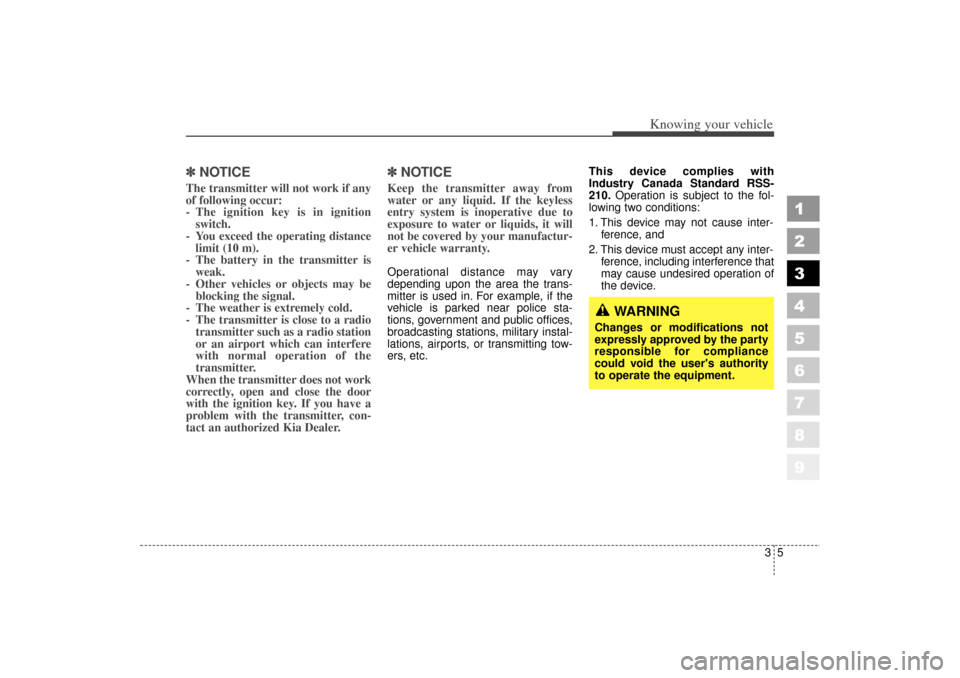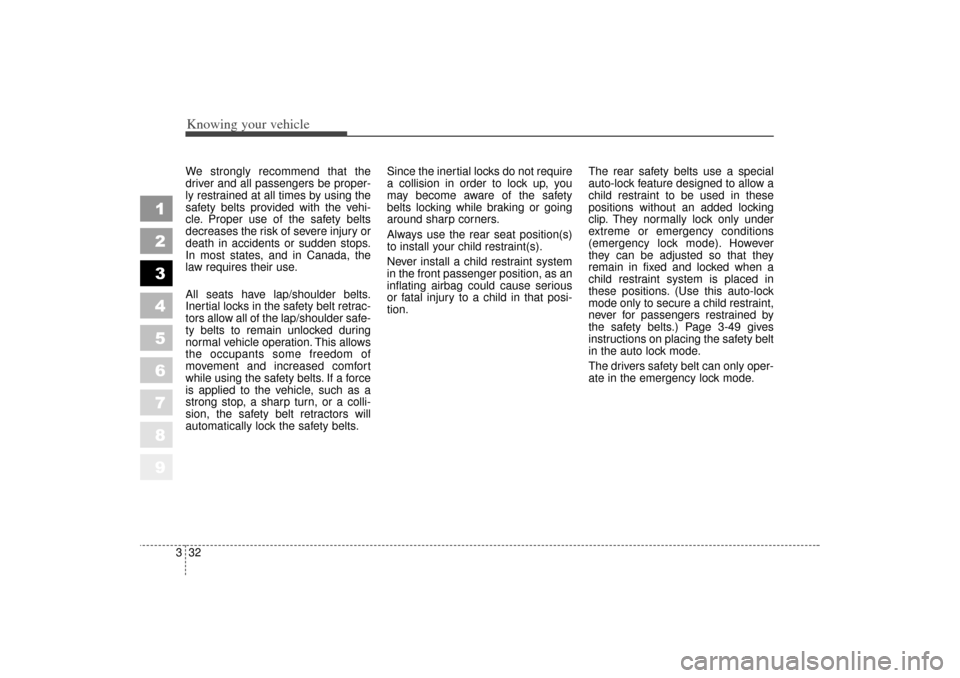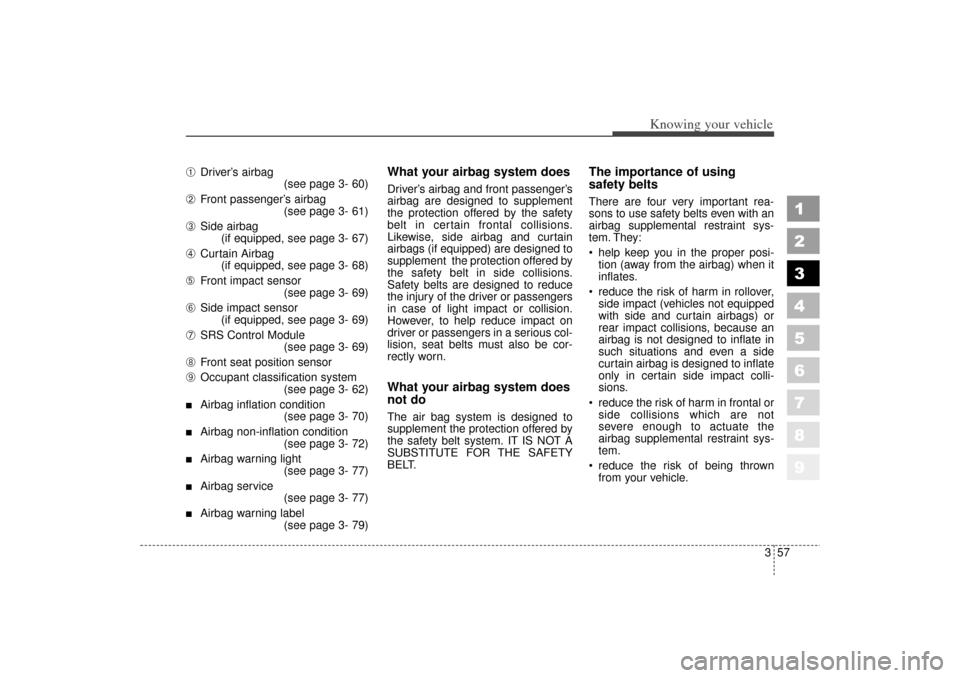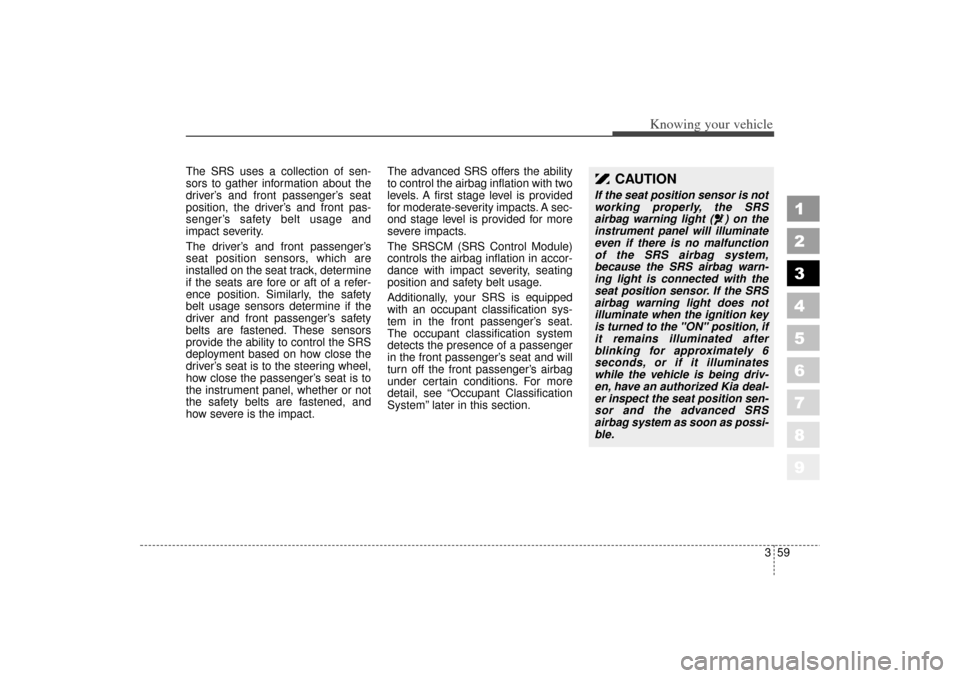air condition KIA Sephia 2006 2.G Owner's Manual
[x] Cancel search | Manufacturer: KIA, Model Year: 2006, Model line: Sephia, Model: KIA Sephia 2006 2.GPages: 273, PDF Size: 2.83 MB
Page 16 of 273

35
1
2
3
4
5
6
7
8
9
Knowing your vehicle
✽ ✽NOTICEThe transmitter will not work if any
of following occur:
- The ignition key is in ignition
switch.
- You exceed the operating distance limit (10 m).
- The battery in the transmitter is weak.
- Other vehicles or objects may be blocking the signal.
- The weather is extremely cold.
- The transmitter is close to a radio transmitter such as a radio station
or an airport which can interfere
with normal operation of the
transmitter.
When the transmitter does not work
correctly, open and close the door
with the ignition key. If you have a
problem with the transmitter, con-
tact an authorized Kia Dealer.
✽ ✽ NOTICEKeep the transmitter away from
water or any liquid. If the keyless
entry system is inoperative due to
exposure to water or liquids, it will
not be covered by your manufactur-
er vehicle warranty. Operational distance may vary
depending upon the area the trans-
mitter is used in. For example, if the
vehicle is parked near police sta-
tions, government and public offices,
broadcasting stations, military instal-
lations, airports, or transmitting tow-
ers, etc. This device complies with
Industry Canada Standard RSS-
210.
Operation is subject to the fol-
lowing two conditions:
1. This device may not cause inter- ference, and
2. This device must accept any inter- ference, including interference that
may cause undesired operation of
the device.
WARNING
Changes or modifications not
expressly approved by the party
responsible for compliance
could void the user's authority
to operate the equipment.
LD CAN (ENG) new 3-1~.qxd 7/29/05 10:28 AM Page 5
Page 43 of 273

Knowing your vehicle32
3
1
2
3
4
5
6
7
8
9
We strongly recommend that the
driver and all passengers be proper-
ly restrained at all times by using the
safety belts provided with the vehi-
cle. Proper use of the safety belts
decreases the risk of severe injury or
death in accidents or sudden stops.
In most states, and in Canada, the
law requires their use.
All seats have lap/shoulder belts.
Inertial locks in the safety belt retrac-
tors allow all of the lap/shoulder safe-
ty belts to remain unlocked during
normal vehicle operation. This allows
the occupants some freedom of
movement and increased comfort
while using the safety belts. If a force
is applied to the vehicle, such as a
strong stop, a sharp turn, or a colli-
sion, the safety belt retractors will
automatically lock the safety belts. Since the inertial locks do not require
a collision in order to lock up, you
may become aware of the safety
belts locking while braking or going
around sharp corners.
Always use the rear seat position(s)
to install your child restraint(s).
Never install a child restraint system
in the front passenger position, as an
inflating airbag could cause serious
or fatal injury to a child in that posi-
tion.
The rear safety belts use a special
auto-lock feature designed to allow a
child restraint to be used in these
positions without an added locking
clip. They normally lock only under
extreme or emergency conditions
(emergency lock mode). However
they can be adjusted so that they
remain in fixed and locked when a
child restraint system is placed in
these positions. (Use this auto-lock
mode only to secure a child restraint,
never for passengers restrained by
the safety belts.) Page 3-49 gives
instructions on placing the safety belt
in the auto lock mode.
The drivers safety belt can only oper-
ate in the emergency lock mode.
LD CAN (ENG) new 3-1~.qxd 7/29/05 10:28 AM Page 32
Page 59 of 273

Knowing your vehicle48
3
1
2
3
4
5
6
7
8
9
Installing a child restraint system
For safety reasons, we recommend
that the child restraint system be
used in the rear seats.
Never place a rear-facing child
restraint in the front passenger
seat, because of the danger that
an inflating passenger side air bag
could impact the rear-facing child
restraint and kill the child.
Since all passenger’ s (except dri-
ver ’s) safety belts move freely under
normal conditions and only lock
under extreme or emergency condi-
tions (emergency lock mode), you
must manually change these safety
belts to the auto lock mode to secure
a child restraint.✽ ✽ NOTICEThe driver’s safety belt incorporates
the emergency lock mode only.
WARNING
Do not install any child
restraint system in the front
passenger seat. Should an
accident occur and cause the
passenger airbag to deploy, it
could severely injure or kill an
infant or child seated in an
infant or child seat. Therefore,
only use a child restraint sys-
tem in the rear seat of your
vehicle.
If the child restraint seat is not anchored properly, the risk of
a child being seriously injured
or killed in a collision greatly
increases.
WARNING
Before installing the childrestraint system, read the
instructions supplied by the
child restraint system manu-
facturer.
If the seat belt does not oper- ate as described, have the
system checked immediately
by your authorized Kia dealer.
Failure to observe this manual instructions regarding child
restraint system and the
instructions provided with the
child restraint system could
increase the chance and/or
severity of injury in an acci-
dent.
LD CAN (ENG) new 3-1~.qxd 7/29/05 10:28 AM Page 48
Page 68 of 273

357
1
2
3
4
5
6
7
8
9
Knowing your vehicle
➀
Driver’s airbag
(see page 3- 60)
➁
Front passenger’ s airbag
(see page 3- 61)
➂
Side airbag (if equipped, see page 3- 67)
➃
Curtain Airbag(if equipped, see page 3- 68)
➄ Front impact sensor
(see page 3- 69)
\b
Side impact sensor(if equipped, see page 3- 69)
➆
SRS Control Module (see page 3- 69)
➇
Front seat position sensor
➈
Occupant classification system(see page 3- 62)
Airbag inflation condition(see page 3- 70)
Airbag non-inflation condition(see page 3- 72)
Airbag warning light(see page 3- 77)
Airbag service(see page 3- 77)
Airbag warning label(see page 3- 79)
What your airbag system doesDriver’s airbag and front passenger’ s
airbag are designed to supplement
the protection offered by the safety
belt in certain frontal collisions.
Likewise, side airbag and curtain
airbags (if equipped) are designed to
supplement the protection offered by
the safety belt in side collisions.
Safety belts are designed to reduce
the injury of the driver or passengers
in case of light impact or collision.
However, to help reduce impact on
driver or passengers in a serious col-
lision, seat belts must also be cor-
rectly worn.What your airbag system does
not doThe air bag system is designed to
supplement the protection offered by
the safety belt system. IT IS NOT A
SUBSTITUTE FOR THE SAFETY
BELT.
The importance of using
safety beltsThere are four very important rea-
sons to use safety belts even with an
airbag supplemental restraint sys-
tem. They:
help keep you in the proper posi-
tion (away from the airbag) when it
inflates.
reduce the risk of harm in rollover,
side impact (vehicles not equipped
with side and curtain airbags) or
rear impact collisions, because an
airbag is not designed to inflate in
such situations and even a side
curtain airbag is designed to inflate
only in certain side impact colli-
sions.
reduce the risk of harm in frontal or
side collisions which are not
severe enough to actuate the
airbag supplemental restraint sys-
tem.
reduce the risk of being thrown
from your vehicle.
LD CAN (ENG) new 3-1~.qxd 7/29/05 10:28 AM Page 57
Page 69 of 273

Knowing your vehicle58
3
1
2
3
4
5
6
7
8
9
Airbag system components The main components of your SRS
are:
To indicate that your vehicle is
equipped with airbags, the corre-
sponding airbag covers are
marked with “SRS AIRBAG”.
- Driver’ s airbag (see page 3- 60)
- Passenger’ s airbag(see page 3- 61)
- Side airbag (if equipped, see page 3- 67)
- Curtain airbag (if equipped, see page 3- 68)
A diagnostic system that continual-
ly monitors the system operation.
An indicator light to warn you of a
possible problem with the system.
Emergency power backup in case
your car’ s electrical system is dis-
connected in a crash.
WARNING
- Airbags &
safety belts
Even in vehicles with air bags, you and your passengers
must always wear the safety
belts provided in order to min-
imize the risk and severity of
injury in the event of a colli-
sion or rollover.
Always wear your safety belt. It can help keep you away
from the air bags during heavy
braking just before a collision.
If occupants are not fastened or correctly seated, they can-
not be protected, and thus
face serious injury or death.
Driver’s and front passenger’s airbag are designed to inflate
only in certain frontal colli-
sions, and side and curtain
airbags (if equipped) are
designed to inflate in certain
side impacts.
(Continued)
(Continued)They will generally not provide
protection in side impacts
(vehicles not equipped with
side and curtain airbags) or
rear impacts, rollovers, less
severe frontal collisions. They
will not provide protection
from later impacts in a multi-
impact collision.
If your vehicle has been sub- jected to flood conditions (e.g.
soaked carpeting/standing
water on the floor of the vehi-
cle, etc.) or if your vehicle has
become flood damaged in any
way, do not attempt to start
the vehicle or put the key in
the ignition before discon-
necting the battery. This may
cause airbag deployment,
which could result in serious
personal injury or death. If
flooded conditions are sub-
jected to your vehicle, before
starting the vehicle, have the
vehicle towed to an authorized
Kia dealer for inspection and
necessary repairs.
LD CAN (ENG) new 3-1~.qxd 7/29/05 10:28 AM Page 58
Page 70 of 273

359
1
2
3
4
5
6
7
8
9
Knowing your vehicle
The SRS uses a collection of sen-
sors to gather information about the
driver’s and front passenger’ s seat
position, the driver’ s and front pas-
senger’ s safety belt usage and
impact severity.
The driver’ s and front passenger’ s
seat position sensors, which are
installed on the seat track, determine
if the seats are fore or aft of a refer-
ence position. Similarly, the safety
belt usage sensors determine if the
driver and front passenger’ s safety
belts are fastened. These sensors
provide the ability to control the SRS
deployment based on how close the
driver’ s seat is to the steering wheel,
how close the passenger’ s seat is to
the instrument panel, whether or not
the safety belts are fastened, and
how severe is the impact. The advanced SRS offers the ability
to control the airbag inflation with two
levels. A first stage level is provided
for moderate-severity impacts. A sec-
ond stage level is provided for more
severe impacts.
The SRSCM (SRS Control Module)
controls the airbag inflation in accor-
dance with impact severity, seating
position and safety belt usage.
Additionally, your SRS is equipped
with an occupant classification sys-
tem in the front passenger’
s seat.
The occupant classification system
detects the presence of a passenger
in the front passenger’ s seat and will
turn off the front passenger ’s airbag
under certain conditions. For more
detail, see “Occupant Classification
System” later in this section.
CAUTION
If the seat position sensor is not
working properly, the SRS
airbag warning light ( ) on the
instrument panel will illuminate
even if there is no malfunction
of the SRS airbag system,
because the SRS airbag warn-
ing light is connected with the
seat position sensor. If the SRS
airbag warning light does not
illuminate when the ignition key
is turned to the "ON" position, if
it remains illuminated after
blinking for approximately 6
seconds, or if it illuminates
while the vehicle is being driv-
en, have an authorized Kia deal-
er inspect the seat position sen-
sor and the advanced SRS
airbag system as soon as possi-
ble.
LD CAN (ENG) new 3-1~.qxd 7/29/05 10:28 AM Page 59
Page 72 of 273

361
1
2
3
4
5
6
7
8
9
Knowing your vehicle
Front passenger’s airbagFront passenger’s airbag is stored in
the instrument panel on the glove
box.
Since you cannot anticipate which
airbags will deploy or from what
direction, never put any objects or
ornaments on the instrument panel. Occupant classification system
The occupant classification system
detects the presence of a passenger
in the front passenger's seat and will
turn off the front passenger's airbag
under certain conditions.
The occupant classification system is
designed to detect the presence of a
properly-seated occupant and deter-
mine if the front passenger's airbag
should be enabled (may inflate) or
not.
Only the front passenger front airbag
and front passenger side airbag are
controlled by the Occupant
Classification System.
WARNING
You must always sit as far
back from the steering wheel
airbag as possible (chest at
least 10 inches (250 mm) away
from the steering wheel), while
still maintaining a comfortable
seating position for good
vehicle control, in order to
reduce the risk of injury or
death in a collision.
Never place objects over the airbag storage compartments
or between the airbags and
yourself. Due to the speed and
force of the airbag inflation,
such objects could hit your
body at high speed and cause
severe bodily injury and even
death.
Do not put stickers or orna- ments on the steering wheel
cover. These may interfere
with the deployment of the
airbag.
1LDA2049HLZ208
1LDN2166
LD CAN (ENG) new 3-1~.qxd 7/29/05 10:28 AM Page 61
Page 74 of 273

363
1
2
3
4
5
6
7
8
9
Knowing your vehicle
The "PASSENGER AIRBAG OFF"
indicator illuminates after the igni-
tion key is turned to the "ON" posi-
tion or after the engine is started. If
the front passenger seat is unoc-
cupied or is occupied by very small
person, or is occupied by someone
who is improperly seated, the
"PASSENGER AIRBAG OFF" indi-
cator will remain illuminated. If the
front passenger seat is occupied
by someone of adult size and body
shape, the "PASSENGER AIRBAG
OFF" indicator will turn off after 6
seconds.
If the "PASSENGER AIRBAG
OFF" indicator illuminates, neither
the front passenger front airbag
nor front passenger side airbag will
deploy in either a side or frontal
collision.
If the "PASSENGER AIRBAG
OFF" indicator is not illuminated,
the front passenger front airbag
and front passenger side airbag
may deploy in either a side or
frontal collision.
Condition and operation in the front passenger occupant
classification systemCondition detected by
the occupant classifi- cation system
1. Adult *
1
2. Child*
2or child
restraint system
3. Unoccupied Off
On
On Off
Off
OffActivated
Deactivated
Deactivated
"PASSENGER AIRBAG OFF" indicator light
SRS warning light Front passenger front
airbag and front
passenger side airbag
Indicator/Warning light
Devices
*1The system detects a person who is generally adult size as an adult, thus allowing the pas-
senger airbag to deploy. When a smaller adult sits in the front passenger seat, the system may
detect their body shape as that of a child, thus preventing airbag deployment.
*2When a larger child who has outgrown a child restraint system sits in the front passenger seat, the system may recognize him/her as an adult depending on his/her body shape or seating
position, thus permitting airbag deployment.
CAUTION
If the "PASSENGER AIRBAG OFF" indicator illuminates or blinks con-
tinuously when a person of adult size sits in the front passenger's
seat , it could be because that person isn't sitting properly in the
seat.If this happens, turn the vehicle off, make sure the seat back is
not reclined, have the passenger center on the seat cushion, with legs
comfortably extended, and the safety belt properly positioned. Restart
the vehicle and have the person remain in this position long enough
to allow the system to detect the person and activate the passenger
airbag.
LD CAN (ENG) new 3-1~.qxd 7/29/05 10:28 AM Page 63
Page 77 of 273

Knowing your vehicle66
3
1
2
3
4
5
6
7
8
9
✽ ✽
NOTICE If luggage or other objects are
placed on the front passenger's
seat or if the temperature of the
seat changes while the seat is unoc-
cupied, the "PASSENGER
AIRBAG OFF" indicator may
blink. These conditions do not
indicate a problem.
Do not put heavy objects on the front
passenger's seat. This may cause
front passenger airbag deployment
in the event of an accident, thus
increasing your repair costs.
1KMN36651KMN3666
- Proper seating position
- Do not put feet on dash-
board.Do Not Do This:Do This:(Continued)
(Continued)
Do not modify or replace the
front passenger seat. This will
disable the OCS unless a prop-
er Kia replacement seat is used.Do not place sharp objects on
the front passenger seat. These
can damage the occupant clas-
sification system, if they punc-
ture the seat cushion. Do not install accessory seatcovers on the front seats,
since these will interfere with
proper sensor operation.
WARNING
The front seat passengerairbag is much larger than the
steering wheel airbag and
inflates with considerably
more force. It can seriously
hurt or kill a passenger who is
not in the proper position and
wearing the safety belt proper-
ly. The front passengers
should always move their seat
as far back as practical and sit
back in their seat.
It is essential that the front pas-
senger always wears their safe-
ty belts, even when the vehicle
is moving in a parking lot or up
a driveway into garage. If the driver brakes the vehicle heavily prior to an impact,
unbelted occupants will be
thrown forward. If the front
passenger is not wearing the
safety belts, they will be direct-
ly in front of the storage com-
partment when deployment
occurs. In that situation, seri-
ous injury or death is possible.
(Continued)
(Continued)
LD CAN (ENG) new 3-1~.qxd 7/29/05 10:29 AM Page 66
Page 78 of 273

367
1
2
3
4
5
6
7
8
9
Knowing your vehicle
Side airbag (if equipped)Side airbags are stored in the left
side of the driver’s seat and right side
of the front passenger’ s seat.
If airbag inflation conditions are met
(side collision), they will inflate.
WARNING
Do not use any accessory seat covers for the vehicle
equipped with side airbags.
Use of seat covers could inter-
fere with side airbag deploy-
ment.
If seat or seat cover is dam-
aged, have the vehicle
checked and repaired by an
authorized Kia dealer. Inform
them that your vehicle is
equipped with side airbags.
Do not make modifications or additions to the seats. If seats
not allowed by Kia Motors are
used, unexpected injury may
result in due to the malfunc-
tion of the airbag system.
1LDA2056
1LDN2050/1LDN2051
(Continued)
Never allow front passengerto put their hands, feet or face
on or close to the instrument
panel. In the event of airbag
deployment, such a misposi-
tioned occupant would be
likely to suffer severe injury or
death.
Never allow children, pregnant women or weak persons to sit
in the front passenger seat.
Do not put child restraint sys-
tem on the front passenger's
seat either. They may be seri-
ously injured by the airbag
inflation when airbag deploys.
Do not put objects or stickers on the instrument panel. Do
not apply any accessory to the
front windshield. Do not install
aftermarket mirrors or acces-
sories on the factory-installed
rearview mirror. Any of these
could interfere with the
deployment of the airbag or
could hit your body at high
speed and cause severe bodi-
ly injury and even death.
LD CAN (ENG) new 3-1~.qxd 7/29/05 10:29 AM Page 67